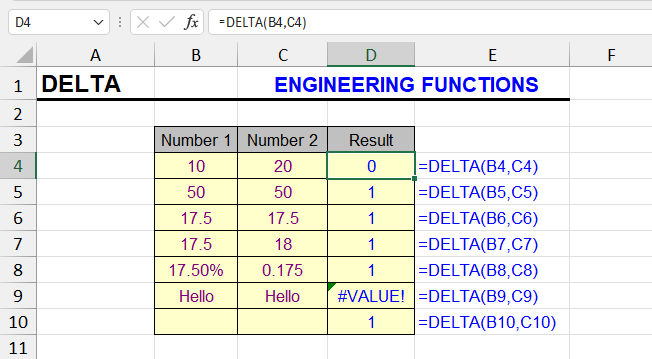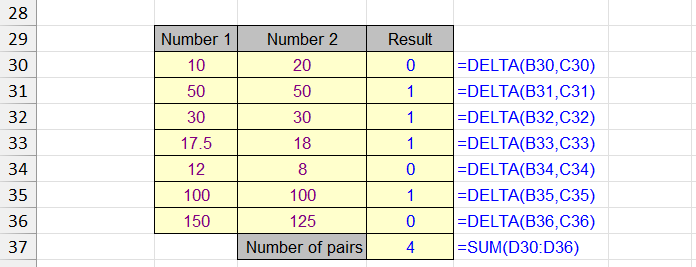
| Function category | Engineering functions |
| Volatility | Non-volatile |
| Similar functions | EXACT |
What does the DELTA function do?
This function compares two values and checks if they are exactly equal.
If the numbers match, the result is 1, otherwise – 0.
Works only with numbers – text values as input return #VALUE! error.
Number formatting doesn’t matter significantly, so numbers that appear rounded due to removed decimal places will still correctly match unrounded values.
DELTA syntax
=DELTA(number1, [number2])
- number1 — required. The first number to compare
- number2 — optional. The second number to compare (defaults to 0 if omitted)
DELTA function examples
The following table is used to determine how many identical number pairs are in the list.
The DELTA function checks each pair, and then the SUM function sums them up.

How to calculate delta (percentage difference) in Excel
Ironically, the DELTA function won’t help you calculate delta in Excel. When comparing data in cells, the function only answers the question: is their delta equal to zero or not (in other words, whether there is a delta).
To calculate the delta between A and B, you don’t need any special functions – just two simple formulas:

The second option is more convenient to use in Excel because the first one requires parentheses.
Don’t let the letters in the formula confuse you – B represents the first measurement (result “before”), and A – the second (result “after”). In other words, A happened after B; their alphabetical order here doesn’t matter.
To express the result as a percentage, change the cell format to percentage.
Delta symbol in Excel
Delta Δ is a letter of the Greek alphabet. If your system language is English rather than Greek, accessing it isn’t straightforward. You can use the “Insert Symbol” menu on the “Insert” tab and find the symbol in the Unicode table. It’s located in the “Greek and Coptic” character set.
But there’s an easier way. To get the delta symbol in Excel, remember the number 916. This is its number in the Unicode table. And the function that turns a number into a symbol is UNICHAR.
=UNICHAR(916)
Practical applications
- Quality control testing for exact matches
- Data validation and consistency checks
- Finding duplicate values in numerical data
- Engineering calculations requiring exact equality
- Financial modeling for exact balance checks
Features
- Returns 1 if numbers are exactly equal, 0 if not
- Treats empty cells as zero
- Text values cause #VALUE! error
- Ignores number formatting – compares actual values
- Similar to EXACT function but for numbers instead of text
Other Engineering functions in Excel
BIN2DEC, DEC2BIN, DEC2HEX, GESTEP, CONVERT, HEX2DEC, DEC2OCT, OCT2DEC
Like the article? Help its author! Buy !SEMTools, it has lots of useful instruments to process text data.